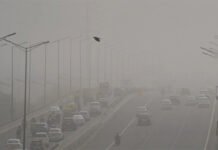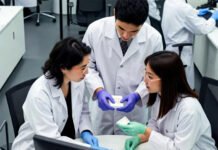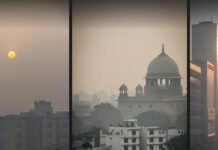Kalpana Palkhiwala**
Environmental laboratories are essential for effective pollution control programme as they provide qualitative as well as quantitative information on pollution. For generating data, the laboratories need to have effective facilities and technically trained specialists. An environment laboratory processes samples taken from air, water, soil, biota etc.
Safe Laboratory Practices
The essential safeguards to avoid hazards have been suggested in the guidelines of such institutions. These guidelines suggest measures for treating toxic or highly inflammable materials or gaseous substances, exhaust fans for proper air circulation and specific arrangement for exhaust doors, securely fastened gas cylinders, ways to avoid exposure to toxic chemicals and solvents during analysis, segregation and separate storing of toxic pollutants. They also suggest provision to dispose off liquid effluents generated from laboratories containing toxic pollutant like mercury and maintenance of appropriate documentation and records to demonstrate that samples have been disposed off as per Rules and that there will be no environmental hazards due to disposal of left-over samples.
Instruments
Important instruments are used in these laboratories to analyse different pollutants. pH meter is used for measurement of acidity and alkalinity. Conductivity Meter determines conductivity, Turbidity Meter determines turbidity/clarity of water, Automatic Absorption Spectrophotometer finds out presence of metals, Flame Photometer are used for determining Sodium, Potassium, Gas Chromatograph determines pesticides and Spectro Photo Meter decides colorimetric analysis.
Central Pollution Control Board (CPCB) has developed affordable water testing kits for quick analysis of water samples. The kits are provided to NGOs/Students.
Specialized Laboratory for Analysis of Micro Pollutants
The CPCB has established a National Reference Laboratory at its central laboratory in Delhi. This laboratory is first of its kind in India with State of art technology for analysis of ultra trace organic pollutants especially for Dioxins and Furans in environmental samples. The main objective of developing this laboratory is to cater to the need of assessment of POP emission form various industrial and other sources as well as their levels in Indian environment and to evolve strategies for mitigation of pollution.
This laboratory is equipped with the advanced instruments like High resolution Mass Spectrophotometer (HRGC-HRMS), High Performance Liquid Chromatograph (HPLC), GAS Chromatograph (FID-ECD-NPD-FPD) etc. for carrying out the tasks.
The CPCB has evolved a set of guidelines for evaluation and recognition of environmental laboratories. The Guidelines provide specification for the infrastructure, instruments and equipments, which are required for analysis of samples, safe laboratory practices including arrangements for exhaust outlets, facilities for management of toxic or highly inflammable material and the provisions for disposal of liquid effluents generated form laboratories containing toxic pollutants like mercury etc. The requirements for waste segregation and its proper storage are also brought out in the Guidelines.
The Ministry of Health & Family Welfare has also undertaken a World Bank assisted Capacity Building Project for Food and Drugs Laboratories for preparation and implementation of an Environment, Health and Safety (EHS) Plan for such laboratories. The activities envisaged in the EHS management plan include standard operating procedures for handling toxic chemicals, precautions for handling laboratory chemicals, evaluation, avoiding under-estimation of risks and prevention of exposure to air borne substances. The project also envisaged to enhance capacity to handle and manage hazardous chemicals and wastes generated in such drug and food testing laboratories.
Salient Features of Guidelines
The guidelines provide for requirements of infrastructure/design, instrumentations for analysis, calibrations of instruments & equipments, quality of reference chemicals to be used in the lab, safe laboratory practices and disposal of unused samples. The legal requirements have also been highlighted in the Guidelines.
Legal Provision for Recognition The need for establishment of environmental laboratories is laid down under various sections of following Acts:
(a) The Water (Prevention and Control of pollution), Act, 1974
Under the Section 17(2) of this Act, the State Board may establish or recognize laboratories to enable the Board to perform its function under various Sections including the analysis of samples of water from any stream or well or of samples of sewage or trade effluents. In this context, the Board is required to appoint Analyst and the analysis report signed by Government /Board Analyst can be used for legal matters.
(b) The Air (Prevention and Control of Pollution) Act, 1981
Under the Section 17(2) of this Act, the State Board may establish or recognize laboratories to enable the Board to perform its function under various Sections of this Act. As in the Water Act, the Board is required to appoint a Government Analyst for analysis of air samples.
(c) The Environment (Protection) Act, 1986
Under the Section 17(2) of this Act, the State Board may establish or recognize one or more laboratory to carry out the functions entrusted to environmental laboratories. Under Section 13, the Government shall appoint Government Analyst for carrying out analysis of samples of air, water, soil or substances sent for analysis to the laboratory established under Section 12.
Eligibility
The Central Government has delegated powers to the Central Pollution Control Board since February, 1991 with respect to grant of recognition to laboratories of Government /autonomous/ public sector undertakings/educational institutions/State Pollution Control Boards. Private laboratories are recognized by the Ministry under Environment Protection Act (EPA).
State Pollution Control Boards set up laboratories through their own resources. Funding support is given by Ministry of Environment and Forests to States for setting/strengthening of laboratories. From time to-time, assistance from foreign agencies like World Bank, Germany, Japanese etc. are taken for strengthening of laboratories of SPCBs and CPCB.
**Deputy Director, Press Information Bureau, New Delhi

















Hey There. I found your blog the usage of msn. That is an extremely well written article. I will be sure to bookmark it and come back to learn extra of your helpful information. Thank you for the post. I will definitely comeback.
Everyone theme likely have some issues, i can’t manage to see your banner header.
Heya i’m for the first time here. I found this board and I in finding It truly useful & it helped me out much. I’m hoping to provide something back and aid others such as you helped me.
Very interesting points you have mentioned , thanks for putting up.
The Internet is like alcohol in some sense. It accentuates what you would do anyway. If you want to be a loner, you can be more alone. If you want to connect, it makes it easier to connect.
Hello there guys, superb website, Thank you very much for the info I really appreciate it!! Appreciated it, i thought this was such an amazing read. We have just bookmarked your web blog. additionally I directed the url to a great friend.
[…] Environmental testing Laboratories | International News and Views […]